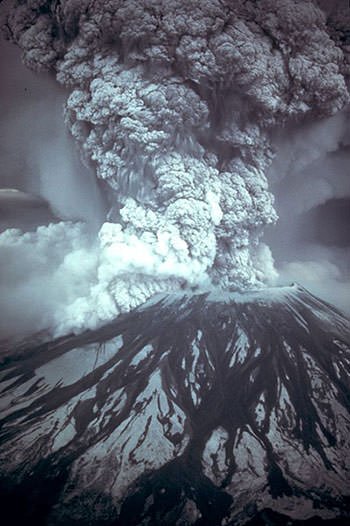Mt. St. Helens 2016
Retrieved from
https://www.washington.edu/news/2016/11/02/new-study-co-authored-by-uw-geologists-looks-at-what-lies-below-mount-st-helens/
It was hard to imagine that such lush flora could prosper after the eruption that occurred back in May of 1980. The Mt. St. Helens eruption of 1980 is still considered the most destructive and deadliest volcanic eruption in U.S. History. Some of the statistics are truly shocking: 57 deaths, thousands of animals killed, 200 homes and over 185 miles of highway destroyed. Another fact that I found truly phenomenal and terrifying was that the eruption of 1980 was actually 1600 times more powerful than the atomic bomb that was dropped on Hiroshima.
May 1980 Eruption
Retrieved from
https://learnodo-newtonic.com/mt-st-helens-eruption-facts
My wife couldn't fathom that such a peaceful area could have been home to such catastrophe, so I was more than eager to offer her a lesson on the geology of Mt. St. Helens. Mt. St. Helens is part of a chain of volcanic mountains known as the Cascade range. This chain of volcanos, extending from southern British Columbia through Washington, Oregon, and northern California, is known for the highest seismic activity in the United States, so it is not really a matter of "if" but a matter of "when" Mt. St Helens will erupt again. In fact, there have been minor volcanic activities that have occurred in recent memory: magma expulsion in October of 2004, an ash plume explosion in October of 2006, and steam and seismic activity occurring in January of 2008. The violence emanated from the eruption of May 1980 was preceded by a series of earthquakes and small explosions; as if the mountain itself was trying to warn everyone of what was about to occur. A few geologic features that have emerged from the eruptions of Mt. St. Helens' 40,000 year history are the growth of a large dome as well as the appearance of glaciers(such as Crater Glacier).
Crater Glacier
Retrieved from
glaciers.us/image-galleries/Crater-Glacier
Understanding Mt. St. Helens' volcanic history, my wife now understood why I was so insistent on taking a trip as soon as possible, lest we become witness to another catastrophe!
References
Bagley, M. (2018). Mount St. Helens Eruption: Facts & Information. Retrieved from https://www.livescience.com/27553-mount-st-helens-eruption.html
Hickey, H. (2016). New study co-authored by UW geologists looks at what lies below Mount St. Helens. Retrieved from https://www.washington.edu/news/2016/11/02/new-study-co-authored-by-uw-geologists-looks-at-what-lies-below-mount-st-helens/
Learnado. (2017). 10 Facts About The 1980 Eruption Of Mt. St. Helens. Retrieved from https://learnodo-newtonic.com/mt-st-helens-eruption-facts
USGS. (2019). Geology and History Summary for Mount St. Helens. Retrieved from https://volcanoes.usgs.gov/volcanoes/st_helens/st_helens_geo_hist_101.html


No comments:
Post a Comment